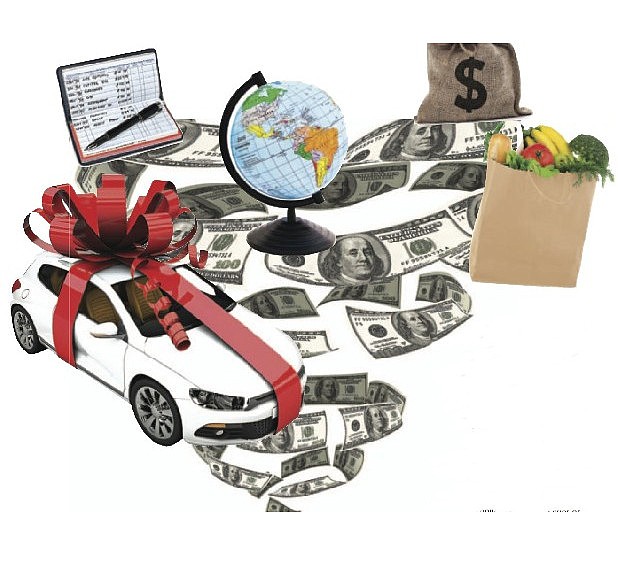Tax refunds by the numbers* $3,034 - Average tax refund this year, up 3 percent from a year ago* 84 - Percent of tax returns filed so far that have received a refund* 88 - Percent of refunds directly deposited into taxpayer accountsSource: Internal Revenue Service What Americans plan to do with tax refunds this year* 30 percent - Pay down debt* 28 percent - Save or invest it* 26 percent - Spend it on necessities* 7 percent - Splurge on a vacation or shopping spree* 9 percent - Something else or don't knowSource: Survey by Bankrate.com
It's tax refund time, which means people dressed like the Statue of Liberty stand alongside busy streets twirling signs to draw customers into tax preparation businesses that offer instant refunds for a fee.
Through the end of February, the average refund this year was $3,034, up 3 percent compared to the average refund amount for the same time last year. The Internal Revenue Service has issued more than 48 million tax refunds so far, up 5.6 percent from a year ago.
All that refund money flooding into the economy is good for many area businesses.
"It's our busiest time of the year," said Jason Wright, the manager of Wright's Motor Co., a buy-here, pay-here used car lot that his family has operated since 1973 on Rossville Boulevard.
"For us, it's kind of like Black Friday," said Dan Davis, a salesman at Wright's Motor Co., referring to the day after Thanksgiving when bargain-hunting crowds pack into malls and big box stores.
Gary Roden, who helps run his family's 38-year-old used car dealership on Rossville Boulevard, said tax refunds are a boost to business this time of year.
"That is one factor," Roden said. "Spring is always the busiest time of the year for various reasons, that being one."
Most Americans responding to a survey by Bankrate.com say they plan to use their tax refunds to pay down debt or add to their savings. But a third say they will spend their refunds, either on necessities or a one-time splurge for a vacation or extra luxury.
Many will use the money they get back from Uncle Sam upgrade their wheels--a phenomenon car dealers call "tax buying season." Some car dealers report that more than 40 percent of their annual sales comes between February and April when most people get their tax refunds and many enjoy the biggest source of discretionary income all year.
Ricky Beggs, editorial director for for the used-car pricing guide know as the Black Book, said used car prices typically rise slightly this time of the year as demand is often the best any time this year.
Area furniture stores also see a boost in business when tax refunds come in.
"It's probably about the busiest time for us," said Ben Harris, a furniture salesman at family-owned H & H Furniture at 2007 McFarland Ave. in Rossville. "We're actually pretty low on merchandise, we've been selling so much stuff."
Earned income credit
Part of what fuels the tax-refund boom is the earned income tax credit, a lump-sum payment in the form of a refund for low- and moderate-income people raising children.
"They're relying on earned income credit," said Kristie Tyler, manager of a local Liberty Tax Service office.
A single mother with three dependents "can bring back $3,000, maybe $4,000, easy," Tyler said.
More than 27 million citizens received almost $63 billion in earned income tax credit in tax year 2012, according to the National Conference of State Legislatures.
According to the IRS, the maximum income at which people can apply for the credit is $51,567 for a married couple filing jointly with three or more qualifying children. The maximum credit in that case would be $6,044. At the other end of the spectrum, a married couple with no children could get a maximum credit of $487 if they earned $19,680 or less.
The federal poverty initiative was enacted in 1975 during Gerald Ford's presidency to offset Social Security taxes and provide an incentive to work. It's been expanded since then, including by President Ronald Reagan who called it the "the best anti-poverty, the best pro-family, the best job creation measure to come out of Congress."
President Barack Obama's recently released budget proposes to expand the earned income tax credit. Obama's proposal would double the maximum credit for childless single adults, raise the maximum amount one can earn and still qualify for the earned income tax credit and lower the minimum age for eligibility to 21 from 25, according to an article published this week by Bloomberg.
"About 7.7 million workers would qualify for a larger credit, and 5.8 million more would become newly eligible for the [earned income tax credit], according to the administration's analysis," the Bloomberg article states. "That could lift 500,000 people out of poverty and reduce impoverishment for 10 million more."
Not everyone is a fan of the earned income tax credit.
The Washington, D.C.-based Tax Foundation, which calls itself the nation's leading independent tax policy research organization, wants the earned income tax credit repealed, saying that would increase employment by the equivalent of about 274,000 full-time workers with little change in the hourly wage
A 2013 audit by the Treasury Inspector General for Tax Administration found that the IRS has made as much as $132 billion in improper earned income tax credit payments over the past decade. Up to 25 percent of payments made in fiscal year 2012 were improper, the federal audit states. The audit blames the payment errors on the complexities of the tax law, taxpayer confusion, a high turnover of claimants, "unscrupulous tax return preparers" and fraud.
Contact staff writer Tim Omarzu at tomarzu@timesfreepress.com or 423-757-6651.

